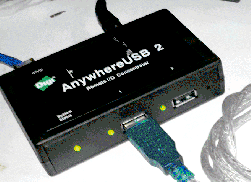 About:
About:
Lets say you have a remote VM server out in the cloud and you want to give it a physical presence in your house by directly mounting USB ports to it WITH OUT introducing any more PCs into your home to reduce power usage. The simplest way to do this is with a USB Network Hub, which are simply USB over TCP concentrators. The problem is, they only work on flat networks; they can not cross firewalls or routers. This is largely because their accompanying connection software running on the host server “discovers” the Hubs via broadcast storms and the USB packets are piped over vast ranges of ports.
The only one I got working was the AnywhereUSB, probably because its network traffic is the cleanest. After packet analyzing it with WireShark, I found that even their manual is lacking some very important information. In fact, their tech support knows absolutely nothing on this topic. Anyway, as the manual says, the Hub only responds on port 3422, but what it doesn’t say is, the connection manager software installed on the server sources all of its packets from ports ranging from 1049 to 1054, luckily only 6 ports. So setting up a single port-forward on your router WILL NOT work.
 Research:
Research:
To packet sniff it, I used an OLD Ethernet HUB (because switches direct packets to the destination only), set the server running the connection manager to 192.168.0.185, the USB-Hub to 192.168.0.10, and plugged in a third computer running WireShark set to capture all TCP and UDP traffic. First I started Wireshark, next I powered up the USB-Hub, last I initiated the connection in the manager.

 Configurations:
Configurations:
To get your cloud server’s connection manager to find this USB-Hub over the internet through your home’s router, you have to set up your router to handle 6 different external ports, 1049-1054, all mapped to internal port 3422 @ the static IP you set your USB-Hub.

|
192.168.0.10 is the IP of the USB-Hub on the private side of my network.
|


|
In the connection manager on your remote server, add the external (public IP) address of your house’s router to the discovery list. Here it is 68.47.xxx.xxx
|

 Testing:
Testing:
Now for the performance testing. I plugged in a USB-to-RS232 dongle here in my house, the device was recognized and installed on the cloud-server, I shorted the Tx and Rx pin on the dongle to hear my own echos, launched a console application, and BAM, works like a champ! It's bee working on this single connection for 2 days now.



 About:
About:
 Research:
Research:

 Configurations:
Configurations:


 Testing:
Testing:


 Viewer Comments
Viewer Comments Leave A Comment
Leave A Comment